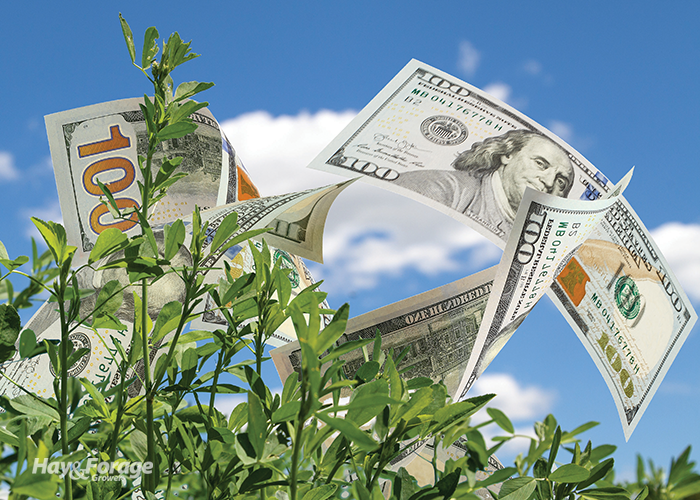Getting more money for hay is no secret |
| By Mike Rankin, Senior Editor |
|
|
 We hear a lot about “value-added” these days. When margins are tight, farmers figure out ways to get more money from the same raw product. Often, that involves skipping the middle man and realizing a chunk of the retail profit through practices such as processing milk or direct marketing meat. Organic production is another way of adding value to a product you are already selling. You get the idea. How do you add value if you’re in the business of producing hay? In most cases, hay already goes direct to the consumer (a livestock owner) in an unprocessed form. I’ve written extensively about the value that small square bales offer compared to larger packages. For this reason, some larger commercial hay operations have added a bale processor to slice and dice their large squares into smaller, bundled bales. This has opened previously unavailable markets and added value to their product. At the same time, they have maintained the efficiency of using large square balers. When hay is short in supply and demand is high, almost any hay will fetch a profit-generating price. Those times are less common than when supply equals demand or exceeds it. For this reason, hay producers need to focus on one well-established strategy that involves little investment but will add value to their product every year, whether selling hay or using it on their own operations. This value-added strategy has been available to hay producers from the first time a scythe was swung to lay down forage; it’s simply accomplished by improving and maintaining hay quality. You’ve heard this story before, but the industry is still nowhere close to meeting its hay quality potential. Regardless of what value-added practice it’s compared against, exceptional hay quality can’t be matched in terms of economic return from both a seller’s and user’s perspective. The difference in price between average quality alfalfa hay and premium quality hay is currently $60 to $80 per ton. A year ago, that difference was close to $100 per ton. Further, making better quality hay doesn’t demand much, if any, additional investment. Here’s why. For the moment, forget about all of the products you can buy that promise higher quality hay. The number one factor that drives hay quality is simply plant maturity at cutting time, and the second most important factor isn’t even close. This is true for grasses and legumes. If you want to receive more money or performance from your hay, weather should be the only thing that prevents a timely cutting. Nobody’s perfect, but . . . Once hay is cut, only bad things happen from a forage quality standpoint, and that’s true regardless of when it’s cut. Therefore, once cut, haymaking becomes a game of maintaining quality rather than improving it. Through research and experience, we know how to minimize quality losses after cutting. Nobody rolls a perfect 300, but you also don’t want to find yourself staring at the equivalent of a 7-10 split. There are no forage quality mulligans. Two keys govern forage quality after cutting: dry-down time and leaf retention. Both of these factors can make or break a hay crop. Dry-down time is impacted by weather conditions, but it is also driven by swath width and conditioning. Swaths should ideally be laid as wide as possible, especially if a tedder or fluffer isn’t used between cutting and raking. Some haymakers like to leave a wide enough gap between swaths to have a dry soil surface for placing the final windrow. Often, these same haymakers will need to ted or fluff the swath if it’s a thick first cutting or the weather is uncooperative. This is done when the plant moisture is still sufficient to hold leaves. And that brings us to the second key. Leaf retention for legumes is the other factor that significantly impacts final forage quality. Leaves make up about 50% of the alfalfa plant and change minimally in forage quality over time. Stems, on the other hand, decline rapidly in forage quality as the plant matures. All of this means that about 70% of the change in final forage quality can be attributed to leaf retention. The opportunity to lose leaves comes during both windrow manipulation and baling or chopping. In all cases, leaf loss usually occurs because the forage is too dry for mechanical handling. Storage matters Even if all of the above factors are minimized, forage quality can easily be compromised during storage. I recently was on a road trip through the Northern Plains and witnessed thousands of tons of forage that were essentially rotting in round bales. These bales were either stacked pyramid style or in single rows but pushed together side-to-side rather than end-to-end. The weeks, months, or years of rain they endured essentially ran off one bale and into another. Again, this was a common sight, not a random stack here and there. The same kind of loss can be seen in a poorly managed, horizontal silo or with any-sized square bales that are not tarped or put under a roof. It’s one thing to lose quality during harvest because of uncontrollable weather factors, but storage is always 100% under the haymaker’s purview. For haymakers, forage quality is the value-added niche, or at least the easiest one. High-quality hay is always in demand and always commands a premium price. Not every load of hay can meet the standard because of uncontrollable weather factors, but making the best quality hay that can possibly be made and stored should always be the end goal. |
